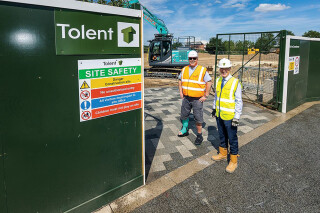Top 100 Construction Companies 2023
The UK’s biggest construction firms show increased turnover and massively improved profits in their latest financial accounts. But since posting those results, pressures have been mounting. Steve Menary reports.
“Turnover is vanity but profit is sanity” is an old stock market adage and at a glance the latest Top 100 shows an industry focused on the bottom line.
Altogether, this year’s Top 100 construction companies turned over £74.5bn in their latest accounts – up by 12.6% on the previous financial year – but profitability surged at a far higher rate as companies emerged from the worst effects of the Covid-19 pandemic.
Those same 100 companies virtually doubled their aggregate pre-tax profits to just over £2bn according to the latest available accounts at Companies House as of July 31st, 2023.
At a superficial level that performance, together with a doubling of the number of construction people appearing in the Sunday Times annual Rich List, suggests an industry in fine fettle as the wider economy sags under pressure from a cost of living crisis and rising interest rates.
The construction industry’s leading players should therefore be in decent shape. But if you dig a bit deeper the picture is far more complex and less positive. While 84 companies in the Top 100 increased turnover and 87 of them made a pre-tax profit in their latest trading year (up from 83 in the previous period) the size of that bottom-line profit figure reduced at 54 of those companies.
The impact of the cost of living crisis is pushing wages up and at the same time driving down the number of staff being employed. Meanwhile cost pressures are continuing to mount both from the cost of importing materials and a massive rise in the price of energy since Russia’s invasion of Ukraine in February 2022.
The knock-on effect is that profit warnings among companies in the FTSE Construction & Materials sector reached their highest level for three years this summer. The impact of a weakening housing market on work in the residential sector has been a major factor behind this rise in profit warnings and this is pushing up the number of companies going to the wall.

Big names that have been lost to the industry this year include Henry Construction Projects and Tolent, which were ranked 45 and 80 respectively in last year’s Top 100.
The total number of construction companies falling into insolvency in the past 12 months reached a 14-year high this summer with plenty of other smaller but familiar regional names also disappearing. Among the casualties are Castlehouse, Claritas, G Works, Howard Russell, ME Construction, Quantum, Metnor, Stewart & Shields and Midlands outfit J Tomlinson, which ceased trading in July.
Amidst the fall-out from those imploding companies, some jobs have been saved. Brims Construction and Re:gen Group, both based in Sunderland, took on former Tolent staff for example. The biggest hits have been further down the supply chain.
The number of specialist contractors going bust doubled in the second quarter of this year. A government decision this summer to block a proposed amendment to the Procurement Bill to include project bank accounts, which can offer greater protection to smaller companies, will have been keenly felt by specialist subcontractors.
There are 13 specialist contractors in the latest Top 100 (compared with 23 last year) and their total turnover was just over £7bn. But three of these companies lost money in their latest trading year and profits slumped at another five.
That contingent of 13 specialist contractors employed nearly 30,000 people, but the workforce was cut at five of these companies to try and stem outgoings on wages, which were subsequently reduced.
The impact of labour issues at specialist contractors across the industry is being felt by the main contractors at the helm of supply chains on major projects.
Karen Booth, chief financial officer at ISG, says: “We are seeing material cost pressures starting to gradually ease and stabilise, however the labour element remains volatile and this is negatively impacting supply chains. Our supply chains are crucial to the health and overall success of the sector and we’re increasingly hearing about labour challenges from our supply chain partners – if this continues this will undoubtedly impact productivity and performance.”
One of the major factors behind the surge in specialist contractors going under is the impact of agreeing fixed price contracts during a boom in material costs.

These supply chain failures can have a major impact on productivity, as main contractors must bring in new companies to start on or complete packages that have already been procured once before. This piles pressure on project management teams and can create delays that incur penalties from clients.
“Most of us are now in the final phases of projects that were procured in 2022, which was the worst time for fixing material prices,” explains Graham Dundas, chief financial officer at Willmott Dixon. “The impact when you take something integral to a project – like an M&E contractor – to the time it takes to replace them is the biggest risk we have faced in the last 18 months. Projects can, and easily do, lose a few months of progress if a subcontractor fails; and it’s the main contractor’s responsibility if a sub-contractor fails."
Dundas explains: “It’s very rare it would be a customer’s responsibility. The impact in terms of damages comes down to what it actually costs a customer. We’ve had a mixture of both where a customer follows up on their contractual responsibility and others where their gratitude to the project and supply chain is so great that they do not.”
As contractors wrestle with supply chain issues, the industry as a whole appears to be preparing to shrink as clients hold back on projects or reduce their aspirations.
“One of the largest challenges that the industry faces in the near term is the impact of project slippage due to high interest rates and scarcity of funding,” adds ISG’s Karen Booth. “Speaking with colleagues across the industry, it’s clear that the current economic landscape is already impacting on funding decisions for customers, and we can expect this squeeze to continue until these inflationary pressures ease.”
A consequence – certainly based on the latest Top 100 analysis – is that many contractors of all types appear to be holding back on recruitment in order to fund pay rises for employees who are struggling under the ongoing cost of living crisis.
Overall, the Top 100 contractors remain major employers, with an aggregate of 209,960 employees according to their latest annual reports. However, that represents an increase in staffing levels of just 1.2% compared with a year ago; meanwhile aggregate wage bills have leapt by 8.8%.
This summer saw job cuts pushed through at a number of major contractors including Bam, Higgins and Lendlease. This should strengthen the bottom line and boost profit margins.
Across the Top 100, the upswing in profitability pushed the average pre-tax profit margin up to 2.72% compared to 1.6% at the same companies a year earlier. That margin increase will have been helped by the slower recruitment but put under pressure by wage rises.
With a pre-tax profit margin of 14.9%, CJ O’Shea (96 on the table) is the most profitable company in the Top 100 this year. Five other companies – Henry Boot, HW Martin, Tarmac, Caddick and Carey – also produced profit margins in double figures, but this was often boosted by income from other sources, notably property development.
Margins were 2% or below at 31 other companies in the Top 100. But a more sobering statistic, as construction heads into another period of wider economic uncertainty, is that profit margins fell at two-thirds of the industry’s biggest contractors. The likelihood is for further job losses as contractors focus on a smaller but hopefully more profitable future.
Top 100 Construction Companies 2023 (theconstructionindex.co.uk)
News by Category
- BECBC
- Cumbria
- Nuclear
- Social Value
- Professional Services
- Clean Energy
- Business
- People
- Government
- BECBC Member News

